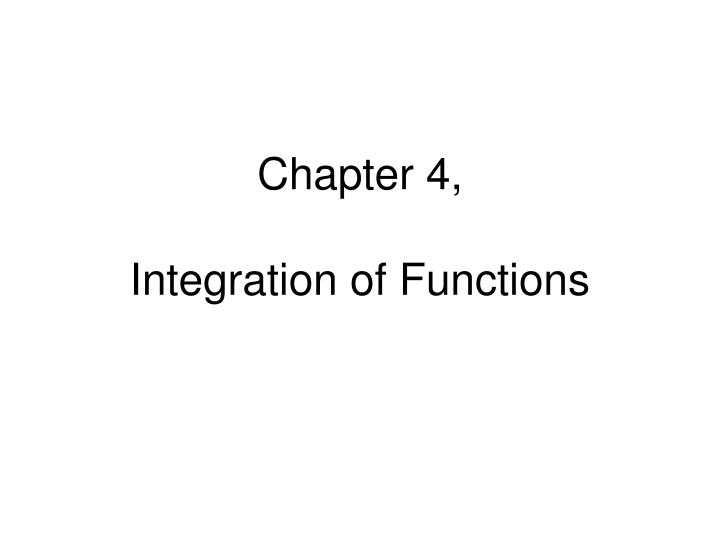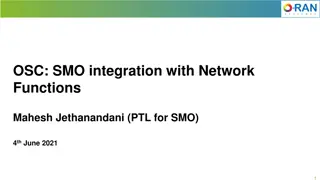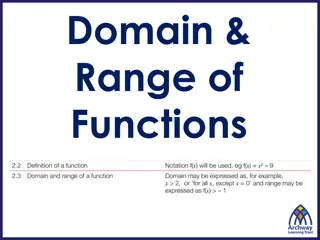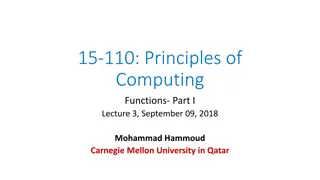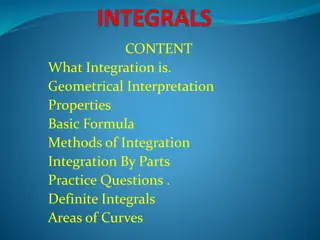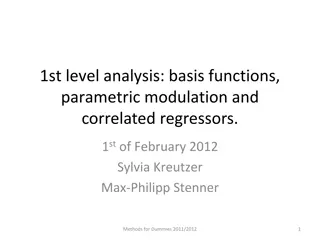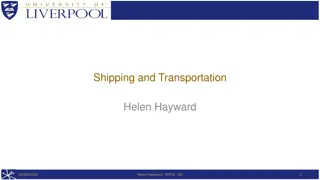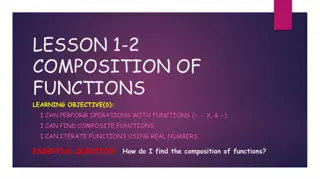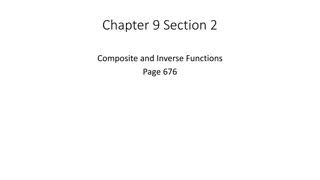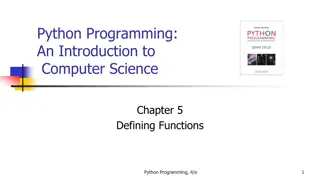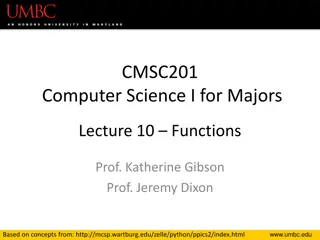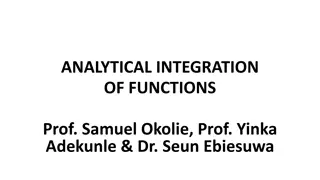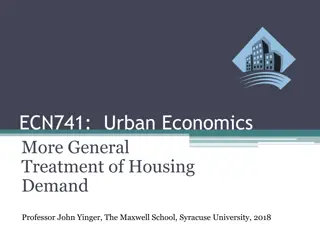Integration of Functions
Explore the integration of functions through open and closed formulas, deriving integration formulas, Closed Newton-Cotes formulas, special cases like N=2,3,4, estimating errors, and open formulas in single intervals. Learn about Newton-Cotes formulas, interpolation, integration rules, and error estimation techniques.
Download Presentation

Please find below an Image/Link to download the presentation.
The content on the website is provided AS IS for your information and personal use only. It may not be sold, licensed, or shared on other websites without obtaining consent from the author.If you encounter any issues during the download, it is possible that the publisher has removed the file from their server.
You are allowed to download the files provided on this website for personal or commercial use, subject to the condition that they are used lawfully. All files are the property of their respective owners.
The content on the website is provided AS IS for your information and personal use only. It may not be sold, licensed, or shared on other websites without obtaining consent from the author.
E N D
Presentation Transcript
Chapter 4, Integration of Functions
Open and Closed Formulas ( ) = f x f 3 3 Open formulas - use interior points only. Extended formulas piecewise sum of integration formula. x1=ax2x3x4x5=b Closed formula uses end points, e.g., b a = + + + + ( ) f x dx w f w f w f w f w f 1 1 2 2 3 3 4 4 5 5
Deriving Integration Formulas A. Given N function values fi, i=1,2, ,N, at xi, interpolate with N 1 degree polynomial, and integrate the polynomial analytically. B. Assuming a form wifi, determine the weights wi by requiring that all polynomials of degree N 1 or less integrate exactly.
Closed Newton-Cotes Formulas Equally spaced abscissas, xj=x1+(j-1)h Lagrange s interpolation formula N P x f l x f x = Where lj(x) is a polynomial of degree N-1 such that lj(xj) = 1 and else lj(xk) = 0 if k j. = ( ) ( ) ( ) j j 1 j Integrating, gives x N ( ) N + = + 1 N ( ) f x dx , w f O h j j = 1 j x 1 x N = = h ( ) w l x dx j j j x 1
Special Cases, N=2,3,4 : the Integration Rules linear interpolation Trapezoidal rule x 1 2 1 2 2 = + + 3 ( ) f x dx ( ) h f f O h f 1 2 x 1 Simpson s rule x parabola 1 3 4 3 1 3 3 = + + + 5 (4) ( ) f x dx ( ) h f f f O h f 1 2 3 x 1 3/8 rule cubic x 3 8 9 8 9 8 3 8 4 = + + + + 5 (4) ( ) f x dx ( ) h f f f f O h f 1 2 3 4 x 1
Estimate the Error Taylor expand the function f(x) around relevant points, e.g. for Trapezoidal rule: 1 ( ) ( ) 2 1 ( ) ( ) 2 ( ) = + + + ' 2 '' 3 ( ) ( ) f x f x x f x x f O x x 1 1 1 1 1 1 ( ) = + + + ' 2 '' 3 ( ) ( ) f x f x x f x x f O x x 2 2 2 2 2 2 Integrate both expressions, add the results and divide by two. Noting ?2 = ?1 + ?1 + ?( 2), we get the trapezoidal rule with error, O(h3f ).
Open Formula in a Single Interval These formulas are useful to construct extended formulas with open interval x 1 ), = + 2 ( ) f x dx ( h f O h f 1 x 0 x 3 2 1 2 1 = + 3 ( ) f x dx ( ) h f f O h f 1 2 x 0 x0 x1 x2 1 1 Open formulas are useful for integrals where the end-point is singular, e.g., dx x 0
Extended Formulas x1 x2 x3 x4 xN Using trapezoidal rule in intervals [x1,x2], [x2,x3], [x3,x4], , and [xN-1,xN ], we get 1 ( ) 2 x x 3 ( ) 1 2 x x f N = + + + + + + 1 2 N f x dx h f f f f f O 1 2 3 1 N N N 1 Using Simpson s rule in intervals [x1,x3], [x3,x5], etc, we get x 1 3 4 3 2 3 4 3 4 3 1 3 1 N = + + + + + + + ( ) f x dx h f f f f f f O 1 2 3 4 1 N N 4 N x 1
Trapezoidal Routine Sequence of points for each iteration n n = 1 n = 2 n = 3 n = 4 2hn n= Subdivide the intervals and compute fi only at points that have not been computed before.
Recursive Computation of Trapezoidal Sum If n = 1 (two points, one interval) 1( 2 ( ) = b a + ) ( ) f a ( ) f b S 1 else if (n > 1) 1 2 b a = + , S S h f 1 n n n j newpoints j = h n 1 n 2
trapzd( ) def FUNC(x): return (x*x) def trapzd(FUNC, a, b, n, s): if n==1: s = 0.5*(b-a)*(FUNC(a)+FUNC(b)) return s else: it = 2**(n-2) d = (b-a)/it x = a + 0.5*d sum = 0.0 for j in range(0,it): sum += FUNC(x) x += d s = 0.5*(s + (b-a)*sum/it) return s Note: d = 2 hn
qtrap(..) call trapzd(..) until convergence def qtrap(FUNC, a, b): EPS = 1.0e-8 JMAX = 20 olds = -1.0e300 s = 0.0 for j in range(1, JMAX): s = trapzd(FUNC,a,b,j,s) if (math.fabs(s-olds) < EPS*math.fabs(olds)): return s if(s == 0.0 and olds == 0.0 and j > 6): return s olds = s res = qtrap(FUNC,0.0,1.0) print(res)
Romberg Integration Compute trapezoidal sum 1 2 1 2 = + + + + ( ) S h h f f f f f 1 2 3 1 N N for different values of h, e.g., h0, h0/2, h0/4, h0/8, etc. Extrapolate S(h) in polynomial of h2 to h 0. The justification for this is due to the Euler- Maclaurin formula.
Euler-Maclaurin Summation Formula 1 2 1 2 = + + + + ( ) S h h f f f f f 1 2 3 1 N N ) ( x 2 k 2 B h B h ( ) N = + + + + (2 1) (2 1) k k 2 ( ) f x dx k 2 2! f f f f 1 1 N N (2 )! k x 1 1 6 1 = = , , B B 2 4 30 The important point is that T(h) is in powers of h2.
Integration Use Scipy 3 4 3 4 x dx = 2 0 from scipy import integrate x2 = lambda x: x**2 integrate.quad(x2,0,4)
Theory of Gaussian Quadrature Find wj and abscissas xj arbitrarily spaced that integrate exactly for all polynomials f(x) up to degree 2N-1: b N = ( ) ( ) f x W x dx ( ) w f x j j = 1 j a where the weight function W(x) is assumed positive and continuous.
Example, 3 points, weight W(x)=1, exact for polynomials up to x5 h + + ( ) f x dx w f w f w f How to find the solution of 6 coupled nonlinear equations? 1 1 2 2 3 3 0 set f(x) =1, x, x2, , x5. h h 2 h = = + + = = + + 1 , , dx h w w w xdx w x w x w x 1 2 3 1 1 2 2 3 3 2 0 0 h h 3 4 h h = = + + = = + + 2 2 2 2 2 3 3 3 2 3 , , x dx w x w x w x x dx w x w x w x 1 1 2 3 3 1 1 2 3 3 3 4 0 0 h h 5 6 h h = = + + = = + + 4 4 4 2 4 5 5 5 2 5 , x dx w x w x w x x dx w x w x w x 1 1 2 3 3 1 1 2 3 3 5 6 0 0
Orthogonal Polynomials Two polynomials are said orthogonal with respect to a fixed weight function W(x) and fixed interval [a,b], if b f g W x f x g x dx | ( ) ( ) ( ) is zero. a One can construct the orthogonal polynomial set {pj(x), j=0,1, 2, } recursively.
Constructing Orthogonal Polynomials Start with the zeroth order P0(x)=1 Let P1(x)=c0+c1x, determine the coefficients by requiring <P0|P1>=0, For weight W(x)=1 in interval [-1,1], this gives P1(x)=x Determine P2(x)= c0+c1x+c2x2 by requiring <P0|P2>=0, <P1|P2>=0 In general Pj+1(x) = (x-aj) Pj(x) bjPj-1(x)
Example of Orthogonal Polynomials With weight W(x) = 1 in interval [-1,1], the corresponding orthogonal polynomials are the Legendre polynomials: k 1 k d ( ) k = 2 ( ) 1 , 0,1,2, P x x k k k 2 ! k dx 2 j P x = | P P i j ij + 2 1 = = ( ) 1, P x ( ) , x 0 1 1 2 ( ) = 2 ( ) 3 1 , P x x 2
Abscissas in Gaussian Quadrature For an N-point integration formula, choose the roots xj of N-th orthogonal polynomial as the abscissas. ???? = 0. Choose wj to satisfy b = b ( ) ( ) , if 0, W x p x dx i N 0 = = ( ) ( ) ( ) W x p x dx w p x i j i j a = 1 j a 0, if 0 . i N It turns out that the integration equal to 0 is true also for i up to 2N-1.
Gaussian integration formula is exact for all polynomials of degree 2N-1 Let f(x) be any polynomial of degree 2N-1, we can write f(x) = q(x) PN(x) + r(x) where r(x) and q(x) are degree N-1. Considering the left- and right-hand side of the integration formula with function f(x), show that they are equal.
It is sufficient to show validity for f(x) = P0=1,P1, ,PN, ..,P2N-1. For 1 to N-1, it is equal to 0 by assumption. For PN, since xj is the roots of PN, b N P x W x dx w P x = = = ( ) ( ) ( ) 0 N j N j 1 j a For i = N+1,N+2, ,2N-1, we write Pi=qPN+r, the first term qPN is 0. Expand r in terms of P0, P1, , PN-1. We need to show coefficient for P0 is the same on both sides of the equation. Equality breaks down for P2N
Solution for the Weight wj | p p = 1 1 N N w j ( ) x p ( ) x p 1 N j N j This formula assumes that the polynomials are normalized according to Eqs.(4.5.6) & (4.57), page 149 of NR.
Reading, References Read Chapter 4 of NR. For an in-depth treatment of numerical methods, see, e.g., J. Stoer and R. Bulirsch, Introduction to Numerical Analysis .
Problems for Lecture 4 (due 3 Oct 2024) 1. Compute the Euler-Maclaurin summation formula for the first three terms, i.e., 1 [ ] 2 1 2 = + + + + S h h f f f f f 1 2 3 1 N N x 2 4 h h N ( ) ( ) N N = + + 6 ( ) f x dx ( ) f f f f O h 1 1 12 720 x 1 where h = (xN-x1)/(N-1). (Hint: Taylor expand & compute recursively.) 2. Use the theory of Gaussian quadrature to find a 3-point integration formula for the weight W(x) = 1 and interval [0, 1]. That is, find the abscissas xj and weights wj such that the formula below is exact for all polynomials of degree 5 or less. 1 f x dx = + + ( ) w f w f w f 1 1 2 2 3 3 0
